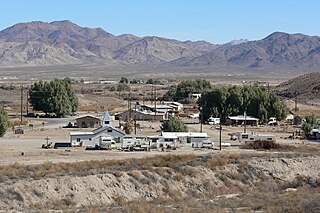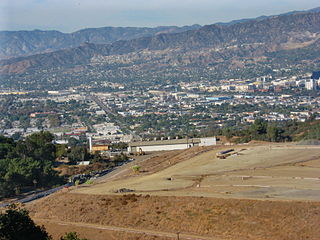Related Research Articles

Tecopa is a census-designated place (CDP) in the Mojave Desert in southeast Inyo County, California, United States. Originally occupied by the Koso and Chemehuevi Indians, Whites began populating what would become the CDP in the late 19th century to support nearby mines. It is now better known for the natural hot springs in the northern part of the CDP. It was the subject of an article by John Gregory Dunne published in the Saturday Evening Post and reprinted in Dunne's book, Quintana & Friends, published by Dutton in 1978.

Kettleman City is a census-designated place (CDP) in Kings County, California, United States. Kettleman City is located 28 miles (45 km) southwest of Hanford, 54 miles (88 km) south of Fresno, at an elevation of 253 feet (77 m), and sits only about 1/2 mile north of the 36th parallel north latitude. It is part of the Hanford-Corcoran Metropolitan Statistical Area. The population was 1,242 at the 2020 census, down from 1,439 at the 2010 census. When travelling between Los Angeles and either San Francisco or Sacramento via Interstate 5, Kettleman City is near the halfway point, and is thus a major stopping point for food and lodging.

The California Department of Water Resources (DWR) is part of the California Natural Resources Agency and is responsible for the management and regulation of the State of California's water usage. The department was created in 1956 by Governor Goodwin Knight following severe flooding across Northern California in 1955, where they combined the Division of Water Resources of the Department of Public Works with the State Engineer's Office, the Water Project Authority, and the State Water Resources Board. It is headquartered in Sacramento.
A landfill tax or levy is a form of tax that is applied in some countries to increase the cost of landfill. The tax is typically levied in units of currency per unit of weight or volume. The tax is in addition to the overall cost of landfill and forms a proportion of the gate fee.

The Toyon Canyon Landfill is located within Griffith Park in the Los Feliz hillside neighborhood of greater Hollywood in central Los Angeles, California in the Santa Monica Mountains. The landfill began filling in 1957 and ended in 1985. A lawsuit in 1959 attempted to stop the project but was unsuccessful. There was a move in the 1980s to expand the landfill into Royce's Canyon to the northwest, but that was defeated.
There is no national law in the United States that mandates recycling. State and local governments often introduce their own recycling requirements. In 2014, the recycling/composting rate for municipal solid waste in the U.S. was 34.6%. A number of U.S. states, including California, Connecticut, Delaware, Hawaii, Iowa, Maine, Massachusetts, Michigan, New York, Oregon, and Vermont have passed laws that establish deposits or refund values on beverage containers while other jurisdictions rely on recycling goals or landfill bans of recyclable materials.

Sanitary engineering, also known as public health engineering or wastewater engineering, is the application of engineering methods to improve sanitation of human communities, primarily by providing the removal and disposal of human waste, and in addition to the supply of safe potable water. Traditionally a branch of civil engineering and now a subset of environmental engineering, in the mid-19th century, the discipline concentrated on the reduction of disease, then thought to be caused by miasma. This was accomplished mainly by the collection and segregation of sewerage flow in London specifically, and Great Britain generally. These and later regulatory improvements were reported in the United States as early as 1865.

The United States produced 5.2 billion metric tons of carbon dioxide equivalent greenhouse gas (GHG) emissions in 2020, the second largest in the world after greenhouse gas emissions by China and among the countries with the highest greenhouse gas emissions per person. In 2019 China is estimated to have emitted 27% of world GHG, followed by the United States with 11%, then India with 6.6%. In total the United States has emitted a quarter of world GHG, more than any other country. Annual emissions are over 15 tons per person and, amongst the top eight emitters, is the highest country by greenhouse gas emissions per person. However, the IEA estimates that the richest decile in the US emits over 55 tonnes of CO2 per capita each year. Because coal-fired power stations are gradually shutting down, in the 2010s emissions from electricity generation fell to second place behind transportation which is now the largest single source. In 2020, 27% of the GHG emissions of the United States were from transportation, 25% from electricity, 24% from industry, 13% from commercial and residential buildings and 11% from agriculture. In 2021, the electric power sector was the second largest source of U.S. greenhouse gas emissions, accounting for 25% of the U.S. total. These greenhouse gas emissions are contributing to climate change in the United States, as well as worldwide.
The Healdsburg Transfer Station is a solid waste recycling and reuse facility in Sonoma County, California, located at 166 Alexander Valley Road, north of the City of Healdsburg. It is privately owned by Republic Services along with all other former Sonoma County transfer stations as of April 1, 2015. Its coordinates are 38.6515°N 122.8686°W.
The Hartland landfill is the waste disposal site for the city of Victoria, British Columbia and the Greater Victoria area. The landfill began operating in the early 1950's under private ownership and management. Phase 1 of the landfill reached capacity in 1996, Phase 2 filled in Heal Lake which was drained and was 2.5-hectares. The landfill was later purchased by the Capital Regional District in 1975 and has been directly operated by its Environmental Sustainability Department since 1985. The landfill, located in the District of Saanich on the southern slope of Mount Work, between Victoria and Sidney, at the end of Hartland Avenue is adjacent to Mount Work Regional Park to the west and the Department of National Defence rifle range is located across Willis Point Road to the northeast. To the east and southeast of the site are residential properties. Undeveloped CRD property lies to the west and south of the landfill site and is now being used by CRD Parks as a mountain bike recreation area under a land use agreement. Private residential properties exist to the east and southeast of the landfill.

Republic Services, Inc. is a North American waste disposal company whose services include non-hazardous solid waste collection, waste transfer, waste disposal, recycling, and energy services. It is the second largest provider of waste disposal in the United States after Waste Management.
The California Department of Resources Recycling and Recovery is a branch of the California Environmental Protection Agency that oversees the state's waste management, recycling, and waste reduction programs. CalRecycle was established in 2010 to replace the California Integrated Waste Management Board. It is known for administering the California Redemption Value (CRV) program, among other responsibilities.

The Kettleman Hills Hazardous Waste Facility is a large hazardous waste and municipal solid waste disposal facility, operated by Waste Management, Inc. The landfill is located at 35.9624°N 120.0102°W, 3.5 mi (5.6 km) southwest of Kettleman City on State Route 41 in the western San Joaquin Valley, Kings County, California.
The Olinda Landfill is a landfill situated in Orange County, California, west of the northern portion of Chino Hills State Park in Carbon Canyon in Olinda neighborhood of Brea City.

West Lake Landfill is a closed, unlined mixed-waste landfill located in Bridgeton, Missouri. It was featured in the 2015 documentaries The First Secret City, The Safe Side of the Fence and the 2017 HBO documentary Atomic Homefront. Its contents have been shown to include radioactive waste; it is thus also an EPA Superfund cleanup site.
The Newby Island Landfill (NISL) is one of the largest active landfills on the shores of the San Francisco Bay. It is located in Santa Clara County, California in the United States. The site is located within the city limits of San Jose, California at the western terminus of Dixon Landing Road. The address is 1601 Dixon Landing Road, Milpitas. Although the address and public street access to the site are both in the City of Milpitas, the landfill property is entirely within the City of San Jose. Newby Island Landfill has a length of 5.07 km (3.15 mi). It is located West of the City of Milpitas near Dixon Landing Road and Interstate 880. It is the terminus for waste for all of San Jose (62%), Santa Clara (14%), Milpitas (10%), Cupertino (5%), Los Altos (2%) and other cities (7%). The 342-acre pile is currently permitted to operate until 2041 and may extend up to 245 feet. The landfill is an island surrounded by a levee which keeps its runoff from directly entering the bay, and the water that drains from it is treated in the landfill's own treatment plant. Electricity for the landfill is generated by burning the methane collected from the decomposition of the waste. Dried sewage sludge from the nearby San José–Santa Clara Regional Wastewater Facility is the material used as cover, mixed in with the trash, blending San Jose's waste streams. It is operated by Republic Services (Republic), which, along with Waste Management Incorporated, transports and disposes of most of the household trash in the United States.

The Scholl Canyon Landfill is a municipal solid waste disposal facility and landfill located in the central San Rafael Hills, within eastern Glendale in Los Angeles County, southern California. The 314 acres (127 ha) of land is located at 3001 Scholl Canyon Road, north of the Ventura Freeway, east of the Glendale Freeway, north of Eagle Rock, and west of the Arroyo Seco. It is owned by the City of Glendale. The landfill opened in 1961.
Tekoi Rocket Test Range, or Tekoi, is a former solid fuel rocket motor test and calibration site operated by Hercules Aerospace near the Utah Test and Training Range in Utah's West Desert, approximately 80 miles (130 km) west of Salt Lake City, Utah. It is located on the Goshute's Skull Valley Indian Reservation.
A balefill is a type of landfill where solid waste is compacted and baled, typically held together with steel strapping or wrapped in plastic.
References
- ↑ Eastlake att swrcb.ca.gov [ dead link ]
- ↑ A Comprehensive Plan for Management of Nonhazardous Waste in California. California Waste Management Board. 1985.
- ↑ (DRR), Department of Resources Recycling and Recovery. "Solid Waste Facility Document Page" (PDF). www.calrecycle.ca.gov.
- ↑ "Site Has Moved" (PDF). www.courtinfo.ca.gov. 30 December 2023.
- ↑ Eastlake Info swrcb.ca.gov [ dead link ]
- ↑ "Eastlake landfill busier than ever" . Retrieved 2018-06-15.
- ↑ "Lake County Board of Supervisors accepts fire debris at Eastlake Landfill". Waste Today. Retrieved 2018-06-15.
38°57′15″N122°36′03″W / 38.95416°N 122.60075°W